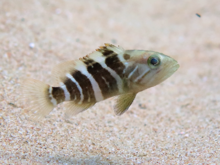White grouper
| White grouper | |
|---|---|

| |
| Scientific classification | |
| Domain: | Eukaryota |
| Kingdom: | Animalia |
| Phylum: | Chordata |
| Class: | Actinopterygii |
| Order: | Perciformes |
| Family: | Serranidae |
| Subfamily: | Epinephelinae |
| Genus: | Epinephelus |
| Species: | E. aeneus
|
| Binomial name | |
| Epinephelus aeneus (Saint-Hilaire, 1817)
| |
| Synonyms[2] | |
| |

The white grouper (Epinephelus aeneus) is a species of marine
Description
The white grouper has a head which is longer than its body is deep, the
Distribution
The white grouper is found in the eastern Atlantic Ocean from southern Portugal and southern Spain south along the western coast of Africa as far south as Angola, including the islands in the Gulf of Guinea. Its occurrence in the Canary Islands and Madeira needs to be verified. It is found in the southern and eastern Mediterranean but appears to be expanding its range northwards being formerly absent north of 44°N in the Adriatic Sea and to be absent from the central Mediterranean but there have been records from Corsica and Monaco, among other recent northerly Mediterranean Sea records.[1] There is a history of vagrancy in this species and the synonym Perca robusta was based on a specimen taken in Cornwall in southwestern England.[3]
Habitat and biology
The white grouper occurs on substrates of rock or mud and sand while the juveniles are found in coastal lagoons and estuaries,
Taxonomy
The white grouper was first formally
Utilisation
The white grouper is a very important quarry species for fisheries throughout its range, fishermen use hook-and-line and trawls to catch it.
References
- ^ . Retrieved 19 November 2021.
- ^ a b c d e Froese, Rainer; Pauly, Daniel (eds.) (2019). "Epinephelus aeneus" in FishBase. December 2019 version.
- ^ ISBN 92-5-103125-8.
- ^ J.C. Hureau. "White grouper (Epinephelus aeneus)". Fishes of the NE Atlantic and Mediterranean. Marine Species Idenitification Portal. Retrieved 23 June 2020.
- ^ Eschmeyer, William N.; Fricke, Ron & van der Laan, Richard (eds.). "Serranus aeneus". Catalog of Fishes. California Academy of Sciences. Retrieved 23 June 2020.

